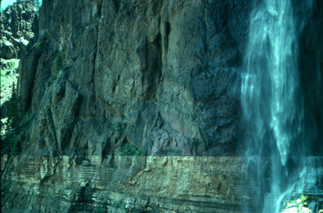 About
50 million years ago, near the modern-day eastern border of Yellowstone National
Park in northwestern Wyoming, an 1,100-square-kilometer block of rock detached
and slipped 50 kilometers to the southeast over nearly horizontal ground. By
the time the Heart Mountain rockslide came to rest upon the much younger Eocene
rocks of the Bighorn Basin, it had broken up and spread to more than 3,500 square
kilometers, making it the largest slide known on land.
About
50 million years ago, near the modern-day eastern border of Yellowstone National
Park in northwestern Wyoming, an 1,100-square-kilometer block of rock detached
and slipped 50 kilometers to the southeast over nearly horizontal ground. By
the time the Heart Mountain rockslide came to rest upon the much younger Eocene
rocks of the Bighorn Basin, it had broken up and spread to more than 3,500 square
kilometers, making it the largest slide known on land.The Heart Mountain fault — a break between dolomite (below) and volcanic rocks (above) — at Jim Smith Creek, Wyo., is site of the largest known terrestrial rockslide. Scientists now say that a cushion of gas buoyed the rock slab, enabling it to quickly travel down a relatively gentle slope. Courtesy of Edward Beutner.
Just how the massive slide could have travelled so far, on a slope of less than 2 degrees, has confounded geologists since its discovery more than 100 years ago. Scientists now say that a cushion of high-pressure carbon dioxide gas, produced by frictional heating of calcium-carbonate rocks along the fault, may have buoyed the Paleozoic carbonate rock and kept it moving. The gas layer would have reduced friction at the base of the up-to-3-kilometer-thick slab to near zero, allowing it to make the trip in mere minutes, says Edward Beutner, emeritus professor of geology at Franklin & Marshall College in Lancaster, Penn.
“It had to happen fast enough so that the friction at the base was sufficient to keep producing gas,” Beutner says. “If it slows down, it stops.”
“I think it’s a pretty creative interpretation of how the thing keeps moving,” says Mark Anders, a structural geologist at Columbia University’s Lamont-Doherty Earth Observatory in Palisades, N.Y., who studies Heart Mountain.
The Heart Mountain detachment fault broke not within a weak layer, as geologists would expect, but within a layer of dolomite (a calcium-magnesium-carbonate rock), creating a carbonate-on-carbonate fault surface. This surface may also explain what eventually stopped the slide, Beutner reported in the May-June GSA Bulletin with co-author Gregory Gerbi, a graduate student at MIT and the Woods Hole Oceanographic Institution.
As it moved out from the area, the fault was no longer sliding carbonate-on-carbonate, so it would not have been producing as much gas, Beutner says. “And then it probably stopped very abruptly.”
As soon as the slide stopped, the cushioning layer would have cooled, particles in it would have settled, and the reactions would have reversed, forming a sinter, or weld, of carbonate cement in the fault plane — a process similar to that used to make concrete cement. “This idea that the basal layer is sintering explains a lot of the observations,” Anders says.
Beutner and Gerbi reached their conclusions based on tiny “accreted” grains in the fault-plane rock layer, which also had characteristics similar to sedimentary rocks that have been deposited out of a fluid suspension. Together, these indicated to the researchers that the sediments in the fault plane were somehow “being carried in suspension along the fault in order to form a sediment rather than a typical fault rock, which is a product of shear or abrasion,” Beutner says.
Many ideas have previously been put forth to explain the unusual movement of the Heart Mountain slide — including earthquake vibration, injection of volcanic fluids and the motion of particles trapped in the fault — but none adequately explained all the evidence or completely ruled out other possibilities.
Although the new theory better explains how the slide moved, the question of what initially triggered it remains to be answered. “You have to get it moving, and [the gas cushion] process only works once it’s moving,” Anders says.
Many geologists think a catastrophic volcanic explosion or the collapse of a volcanic complex could have set the slide in motion. In the Eocene, Wyoming and Montana experienced intense volcanic activity, as evidenced by the Absaroka Volcanic Supergroup that extends over 18,000 square kilometers. Anders, however, questions the interpretation of a volcanic trigger and plans soon to publish a different theory on what initiated the rockslide.
Sara Pratt
Geotimes contributing writer

